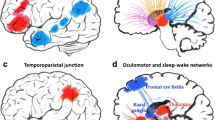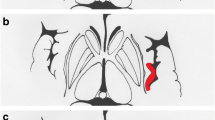Abstract
Numerous crossed brain stem syndromes have been described, especially in the nineteenth century. While these syndromes are passed on in neurological textbooks, their relevance in clinical neurology remains to be elucidated. To investigate the prevalence of classical crossed brain stem syndromes in clinical practice, we prospectively recruited 308 consecutive patients with signs and symptoms indicative of acute brain stem infarction. Standardized high-resolution MR imaging and multimodal electrophysiological brain stem testing were applied to localize the site of the acute lesion. We performed a computer-based correlation of clinical signs and symptoms of our patients to those reported in the original historical publications for more than 25 crossed brain stem syndromes. Fourteen cases matched the clinical criteria of Wallenberg’s syndrome, two patients had Babinski-Nageotte’s syndrome, two had Raymond-Cestan’s, one showed Weber’s, and one Claude’s syndrome. All other tested syndromes were not present in the cohort. More than 20% of patients showed different, so far unnamed crossed symptom combinations. In conclusion, except for Wallenberg’s syndrome, classical crossed brain stem syndromes do not seem to play a relevant role in clinical neurology. Other syndromes may serve as theoretical models only that illustrate possible neuroanatomical connections in the human brain stem. This is complicated, however, by considerable topographic and terminological inconsistencies.

Similar content being viewed by others
References
Avellis G (1891) Klinische Beiträge zur halbseitigen Kehlkopflähmung. Berliner Klinik 10:1–26
Fitzek S, Fitzek C, Marx J, Speckter H, Urban PP, Thömke F, Stoeter P, Hopf HC (1999) Blink reflex R2 changes and localisation of lesions in the lower brainstem (Wallenberg’s syndrome): an electrophysiological and MRI study. J Neurol Neurosurg Psychiatry 67:630–636
Foville A (1858) Paralysie de certains muscles de l’oeil. Bull Mèm Soc Anat Paris 33:406–410
Krasnianski M, Winterholler M, Neudecker S, Zierz S (2003) Klassische alternierende Medulla-oblongata-Syndrome. Eine historisch-kritische und topodiagnostische Analyse. Fortschr Neurol Psychiatr 71:397–405
Krasnianski M, Neudecker S, Zierz S (2003) Die klassischen Syndrome von Schmidt und Vernet: Alternierende Hirnstammsyndrome, die nicht existieren? Nervenarzt 74:1150–1154
Krasnianski M, Neudecker S, Zierz S (2004) Klassische alternierende Syndrome der Brücke. Eine historisch-kritische und topodiagnostische Analyse. Fortschr Neurol Psychiatr 72:460–468
Liu GT, Crenner CW, Logigian EL, Charness ME, Samuels MA (1992) Midbrain syndromes of Benedikt, Claude and Nothnagel: setting the records straight. Neurology 42:1820–1822
Marx JJ, Mika-Gruettner A, Thoemke F, Fitzek S, Fitzek C, Vucurevic G, Urban PP, Stoeter P, Hopf HC (2002) Diffusion weighted magnetic resonance imaging in the diagnosis of reversible ischaemic deficits of the brainstem. J Neurol Neurosurg Psychiatry 72:572–575
Millard A (1856) Hémorrhagie de la protubérance annulaire. Extrait du rapport de M. Millard. Gaz Hebdomad Méd Chir 3:816–818
Parinaud H (1883) Paralysie des mouvements associés des yeux. Arch Neurol 5:154–172
Sacco RL, Freddo L, Bello JA, Odel JG, Onesti ST, Mohr JP (1993) Wallenberg’s lateral medullary syndrome. Clinical-magnetic resonance imaging correlations. Arch Neurol 50:609–614
Schaltenbrand G, Wahren W (1977) Atlas for stereotaxy of the human brain. Thieme, Stuttgart
Schmidt D (2000) Die klassischen Hirnstammsyndrome. Definitionen und Geschichte. Opthalmologe 97:411–417
Schmidt M (1897) Die Krankheiten der oberen Luftwege. Springer, Berlin, p 48
Silverman IE, Liu GT, Volpe NJ, Galetta SL (1995) The crossed paralyses. The original brain-stem syndromes of Millard-Gubler, Foville, Weber, and Raymond-Cestan. Arch Neurol 52:635–638
Vernet M (1918) Syndrome du trou dechire posterieur (paralysie des IX, X, XII). Rev Neuro 34:117–148
Wallenberg A (1895) Acute Bulbäraffection (Embolie der Art. cerebellar. post. inf. sinistr.?). Arch Psych Nervenheilkd 27:504–540
Acknowledgments
The study was supported by the DFG (Deutsche Forschungsgemeinschaft: Ho293/10-2).
Author information
Authors and Affiliations
Corresponding author
Rights and permissions
About this article
Cite this article
Marx, J.J., Thömke, F. Classical crossed brain stem syndromes: myth or reality?. J Neurol 256, 898–903 (2009). https://doi.org/10.1007/s00415-009-5037-2
Received:
Accepted:
Published:
Issue Date:
DOI: https://doi.org/10.1007/s00415-009-5037-2




